Critical Analysis: Five Key Approaches to Leadership Theories
VerifiedAdded on 2023/06/15
|16
|1390
|351
Report
AI Summary
This report provides an overview of five distinct leadership approaches: Situational Leadership, Transformational Leadership, Path-Goal Theory, Trait-Based Leadership Theory, and Style Theory. It delves into the core principles of each theory, highlighting their strengths, weaknesses, and suitability for different contexts. Situational Leadership emphasizes adaptability based on follower readiness, while Transformational Leadership focuses on inspiring and motivating followers through a shared vision. Path-Goal Theory centers on clarifying paths for followers to achieve goals, and Trait-Based Theory identifies specific qualities that define effective leaders. Style Theory, also known as Behavioral Theory, examines the behaviors of leaders and their impact on employee satisfaction and performance. The report uses examples from various sectors to illustrate the practical application of each approach and concludes by referencing academic sources that support the analysis.

Leadership
The five approaches to Leadership
The five approaches to Leadership
Paraphrase This Document
Need a fresh take? Get an instant paraphrase of this document with our AI Paraphraser
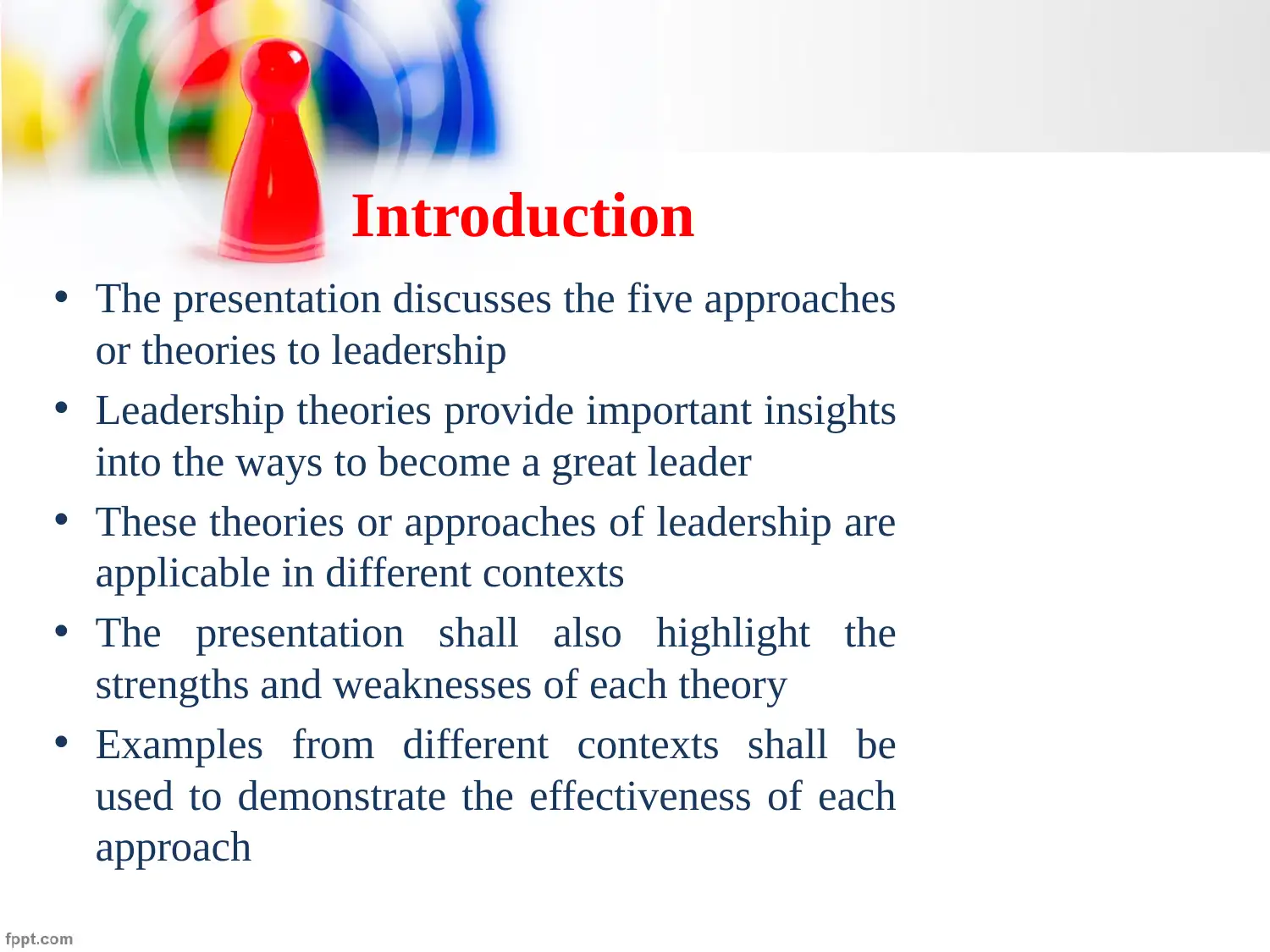
Introduction
• The presentation discusses the five approaches
or theories to leadership
• Leadership theories provide important insights
into the ways to become a great leader
• These theories or approaches of leadership are
applicable in different contexts
• The presentation shall also highlight the
strengths and weaknesses of each theory
• Examples from different contexts shall be
used to demonstrate the effectiveness of each
approach
• The presentation discusses the five approaches
or theories to leadership
• Leadership theories provide important insights
into the ways to become a great leader
• These theories or approaches of leadership are
applicable in different contexts
• The presentation shall also highlight the
strengths and weaknesses of each theory
• Examples from different contexts shall be
used to demonstrate the effectiveness of each
approach
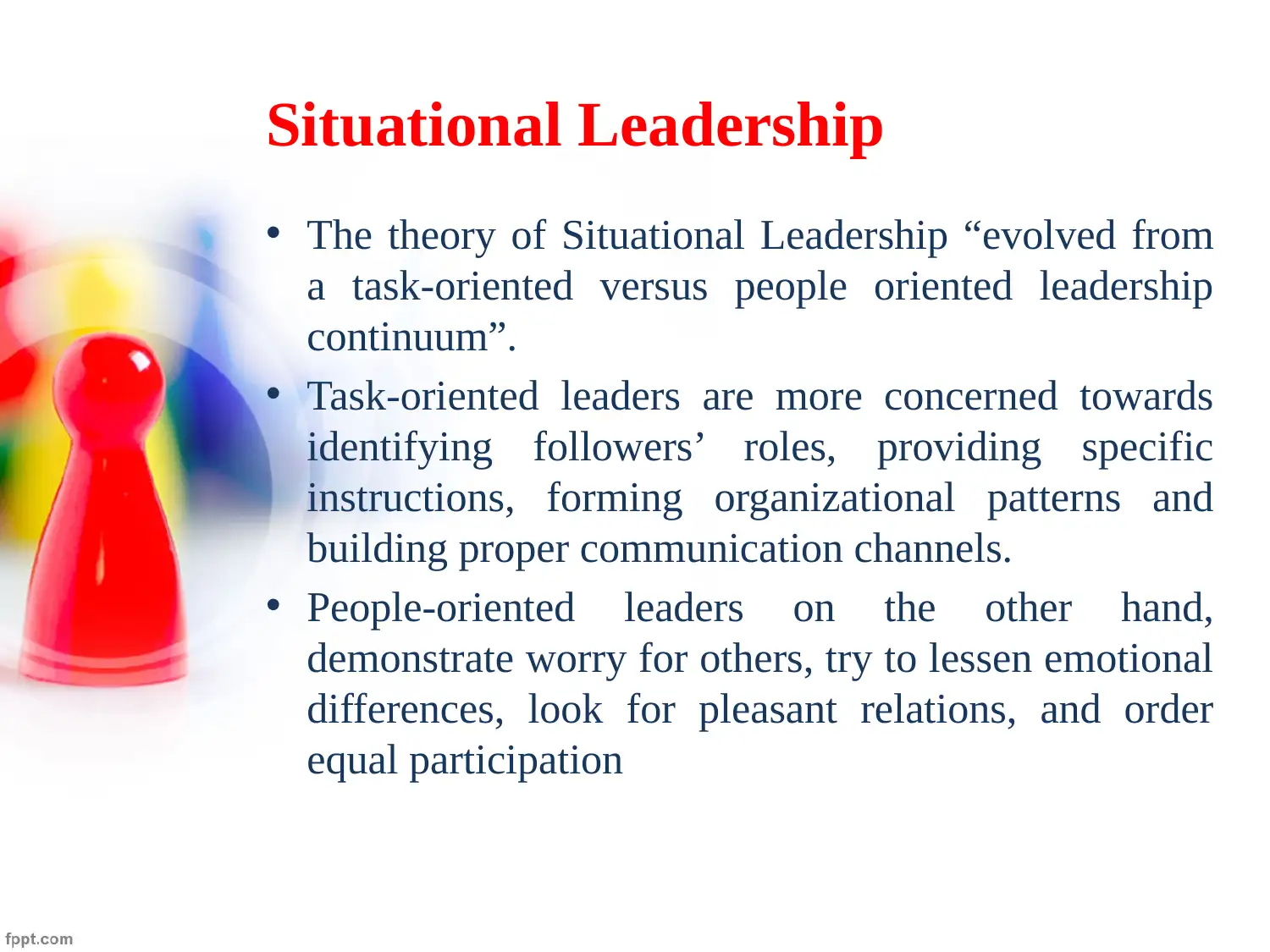
Situational Leadership
• The theory of Situational Leadership “evolved from
a task-oriented versus people oriented leadership
continuum”.
• Task-oriented leaders are more concerned towards
identifying followers’ roles, providing specific
instructions, forming organizational patterns and
building proper communication channels.
• People-oriented leaders on the other hand,
demonstrate worry for others, try to lessen emotional
differences, look for pleasant relations, and order
equal participation
• The theory of Situational Leadership “evolved from
a task-oriented versus people oriented leadership
continuum”.
• Task-oriented leaders are more concerned towards
identifying followers’ roles, providing specific
instructions, forming organizational patterns and
building proper communication channels.
• People-oriented leaders on the other hand,
demonstrate worry for others, try to lessen emotional
differences, look for pleasant relations, and order
equal participation
⊘ This is a preview!⊘
Do you want full access?
Subscribe today to unlock all pages.

Trusted by 1+ million students worldwide
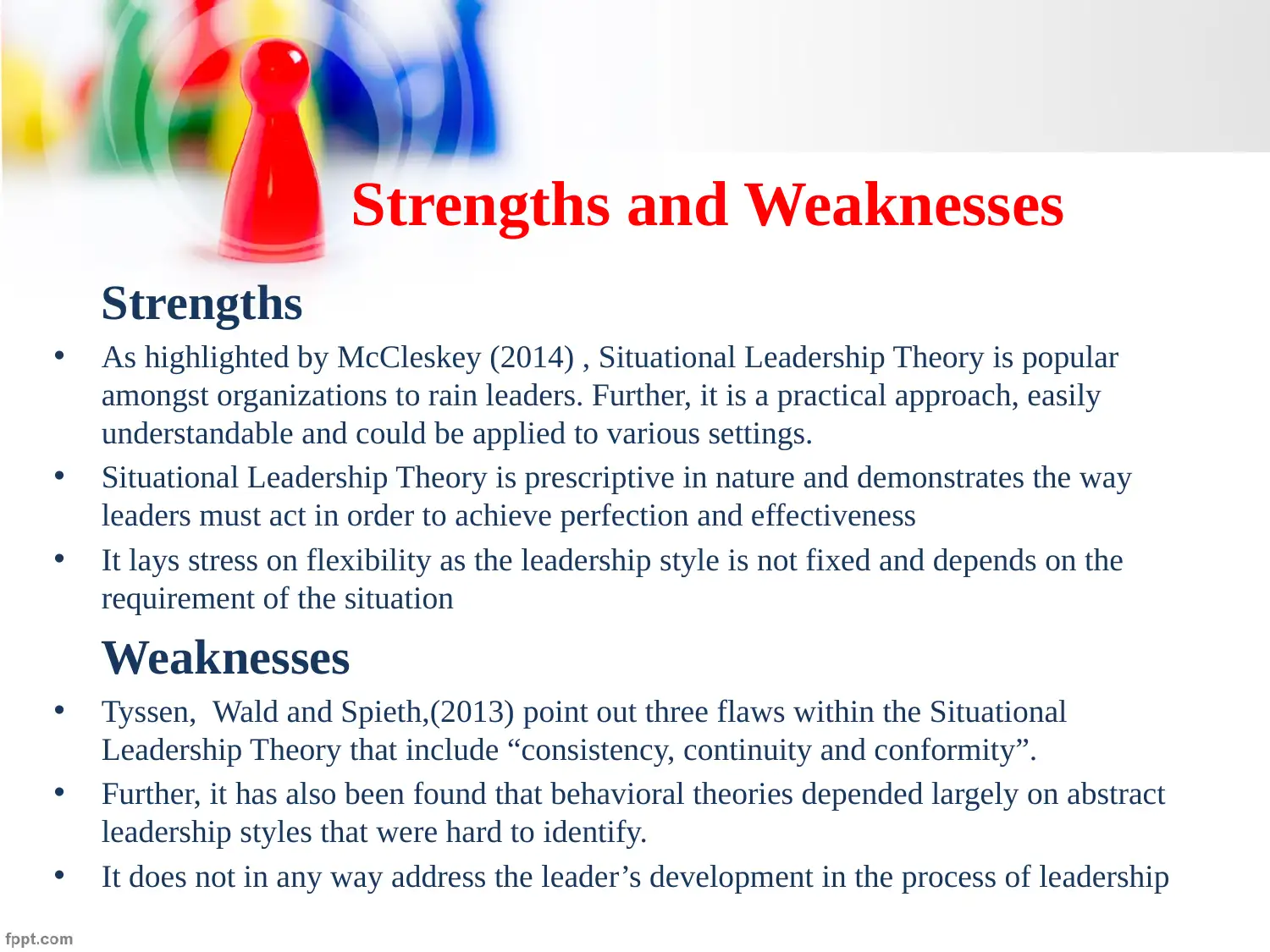
Strengths and Weaknesses
Strengths
• As highlighted by McCleskey (2014) , Situational Leadership Theory is popular
amongst organizations to rain leaders. Further, it is a practical approach, easily
understandable and could be applied to various settings.
• Situational Leadership Theory is prescriptive in nature and demonstrates the way
leaders must act in order to achieve perfection and effectiveness
• It lays stress on flexibility as the leadership style is not fixed and depends on the
requirement of the situation
Weaknesses
• Tyssen, Wald and Spieth,(2013) point out three flaws within the Situational
Leadership Theory that include “consistency, continuity and conformity”.
• Further, it has also been found that behavioral theories depended largely on abstract
leadership styles that were hard to identify.
• It does not in any way address the leader’s development in the process of leadership
Strengths
• As highlighted by McCleskey (2014) , Situational Leadership Theory is popular
amongst organizations to rain leaders. Further, it is a practical approach, easily
understandable and could be applied to various settings.
• Situational Leadership Theory is prescriptive in nature and demonstrates the way
leaders must act in order to achieve perfection and effectiveness
• It lays stress on flexibility as the leadership style is not fixed and depends on the
requirement of the situation
Weaknesses
• Tyssen, Wald and Spieth,(2013) point out three flaws within the Situational
Leadership Theory that include “consistency, continuity and conformity”.
• Further, it has also been found that behavioral theories depended largely on abstract
leadership styles that were hard to identify.
• It does not in any way address the leader’s development in the process of leadership
Paraphrase This Document
Need a fresh take? Get an instant paraphrase of this document with our AI Paraphraser
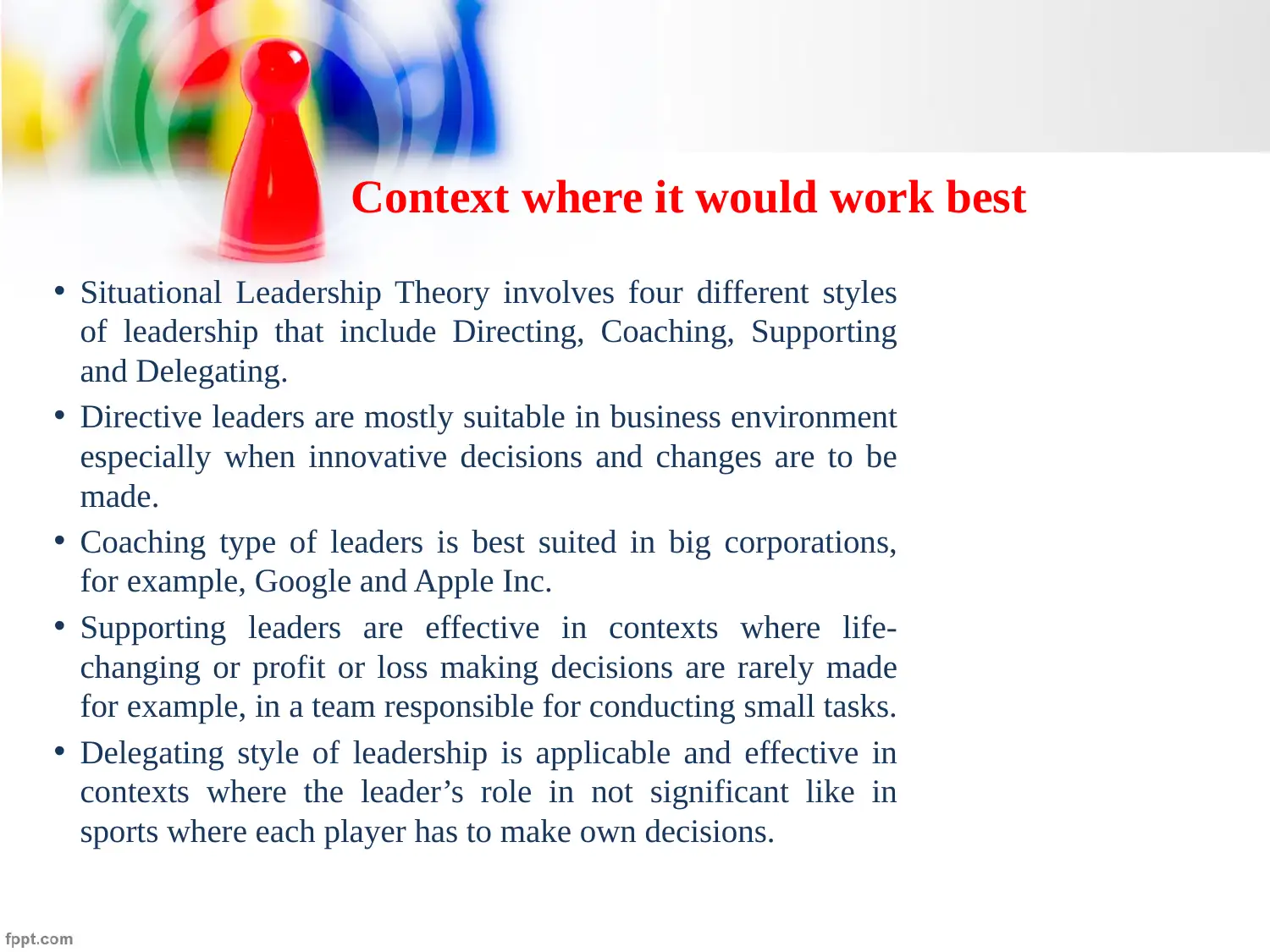
Context where it would work best
• Situational Leadership Theory involves four different styles
of leadership that include Directing, Coaching, Supporting
and Delegating.
• Directive leaders are mostly suitable in business environment
especially when innovative decisions and changes are to be
made.
• Coaching type of leaders is best suited in big corporations,
for example, Google and Apple Inc.
• Supporting leaders are effective in contexts where life-
changing or profit or loss making decisions are rarely made
for example, in a team responsible for conducting small tasks.
• Delegating style of leadership is applicable and effective in
contexts where the leader’s role in not significant like in
sports where each player has to make own decisions.
• Situational Leadership Theory involves four different styles
of leadership that include Directing, Coaching, Supporting
and Delegating.
• Directive leaders are mostly suitable in business environment
especially when innovative decisions and changes are to be
made.
• Coaching type of leaders is best suited in big corporations,
for example, Google and Apple Inc.
• Supporting leaders are effective in contexts where life-
changing or profit or loss making decisions are rarely made
for example, in a team responsible for conducting small tasks.
• Delegating style of leadership is applicable and effective in
contexts where the leader’s role in not significant like in
sports where each player has to make own decisions.
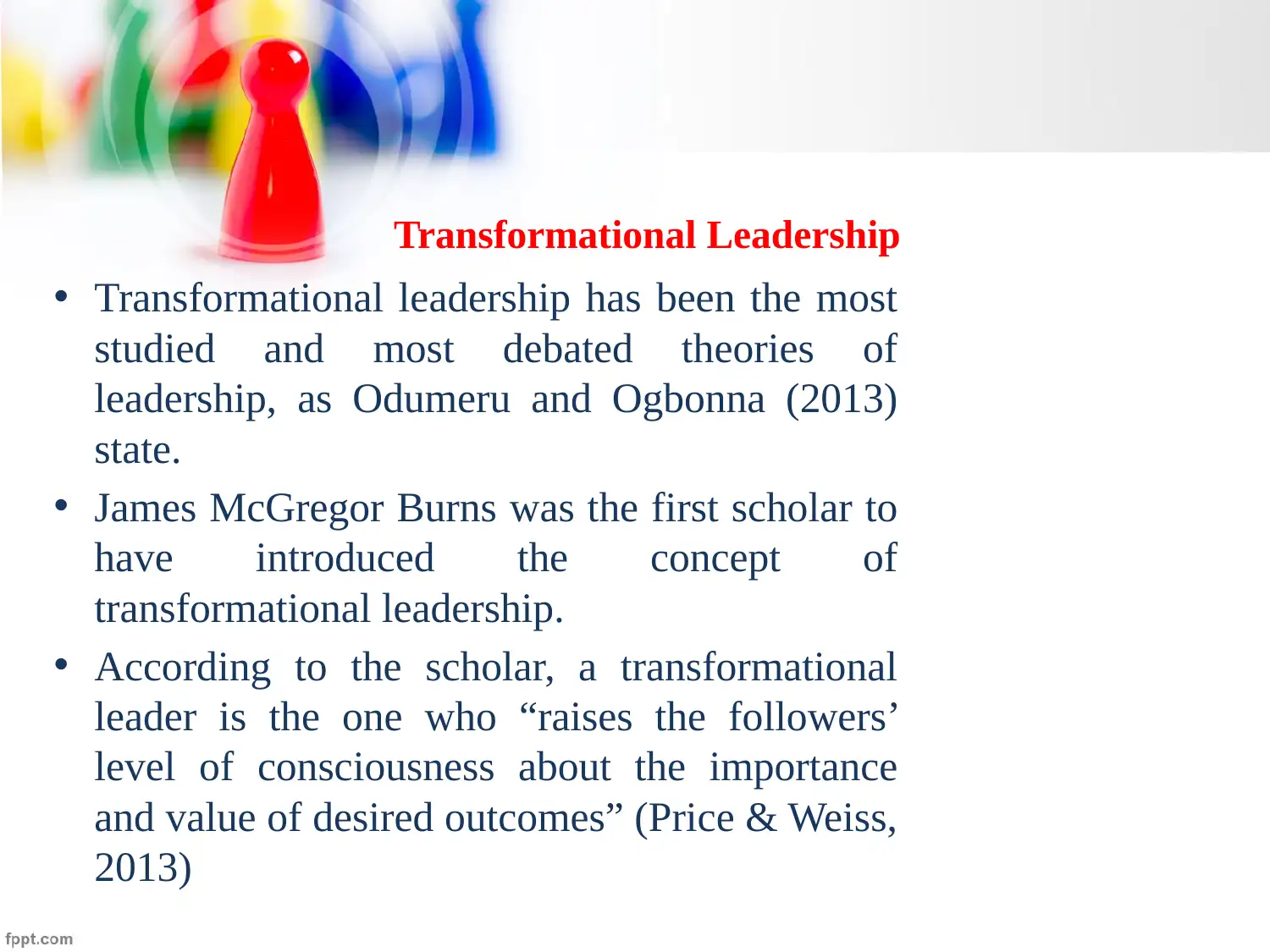
Transformational Leadership
• Transformational leadership has been the most
studied and most debated theories of
leadership, as Odumeru and Ogbonna (2013)
state.
• James McGregor Burns was the first scholar to
have introduced the concept of
transformational leadership.
• According to the scholar, a transformational
leader is the one who “raises the followers’
level of consciousness about the importance
and value of desired outcomes” (Price & Weiss,
2013)
• Transformational leadership has been the most
studied and most debated theories of
leadership, as Odumeru and Ogbonna (2013)
state.
• James McGregor Burns was the first scholar to
have introduced the concept of
transformational leadership.
• According to the scholar, a transformational
leader is the one who “raises the followers’
level of consciousness about the importance
and value of desired outcomes” (Price & Weiss,
2013)
⊘ This is a preview!⊘
Do you want full access?
Subscribe today to unlock all pages.

Trusted by 1+ million students worldwide
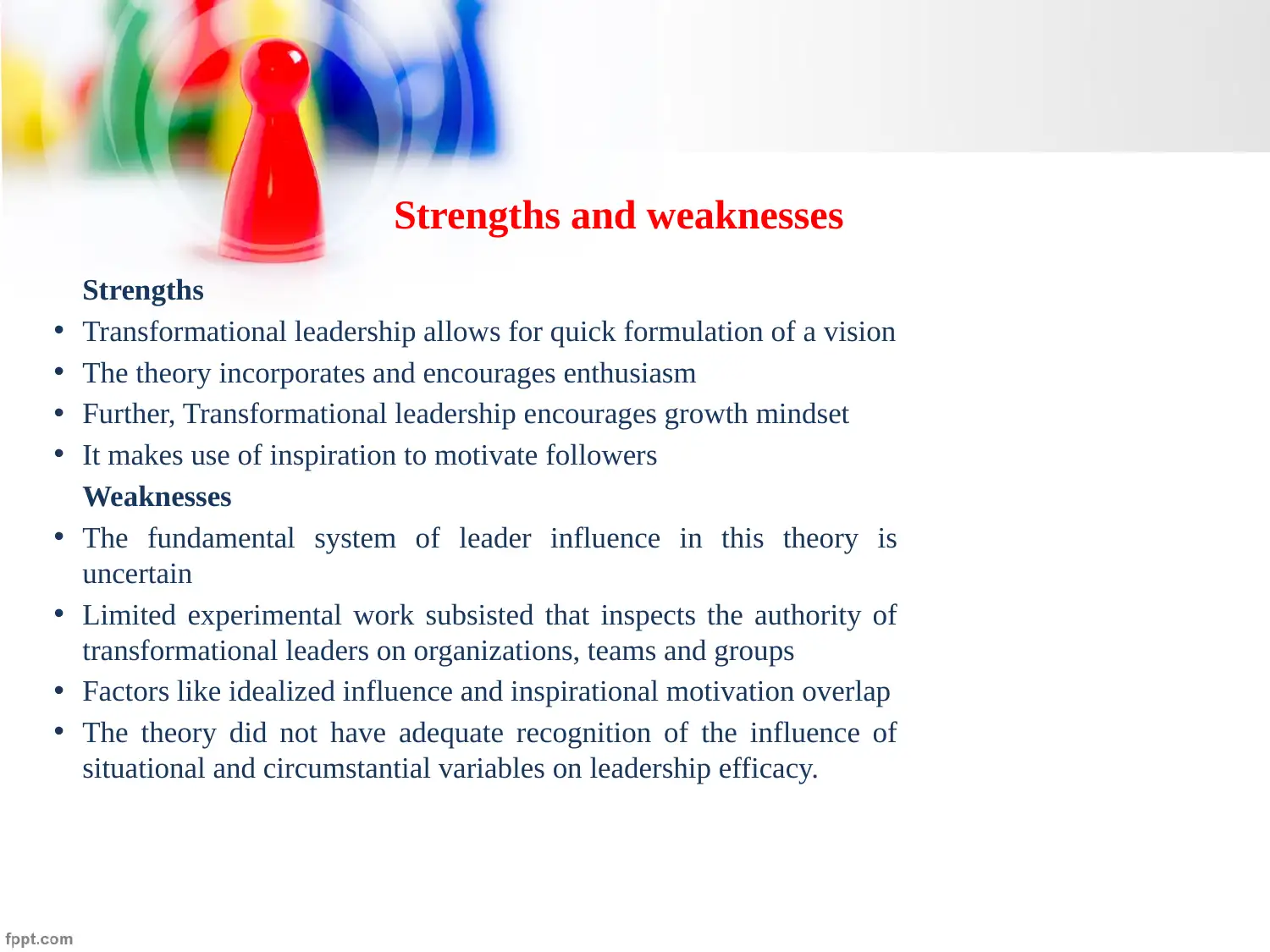
Strengths and weaknesses
Strengths
• Transformational leadership allows for quick formulation of a vision
• The theory incorporates and encourages enthusiasm
• Further, Transformational leadership encourages growth mindset
• It makes use of inspiration to motivate followers
Weaknesses
• The fundamental system of leader influence in this theory is
uncertain
• Limited experimental work subsisted that inspects the authority of
transformational leaders on organizations, teams and groups
• Factors like idealized influence and inspirational motivation overlap
• The theory did not have adequate recognition of the influence of
situational and circumstantial variables on leadership efficacy.
Strengths
• Transformational leadership allows for quick formulation of a vision
• The theory incorporates and encourages enthusiasm
• Further, Transformational leadership encourages growth mindset
• It makes use of inspiration to motivate followers
Weaknesses
• The fundamental system of leader influence in this theory is
uncertain
• Limited experimental work subsisted that inspects the authority of
transformational leaders on organizations, teams and groups
• Factors like idealized influence and inspirational motivation overlap
• The theory did not have adequate recognition of the influence of
situational and circumstantial variables on leadership efficacy.
Paraphrase This Document
Need a fresh take? Get an instant paraphrase of this document with our AI Paraphraser
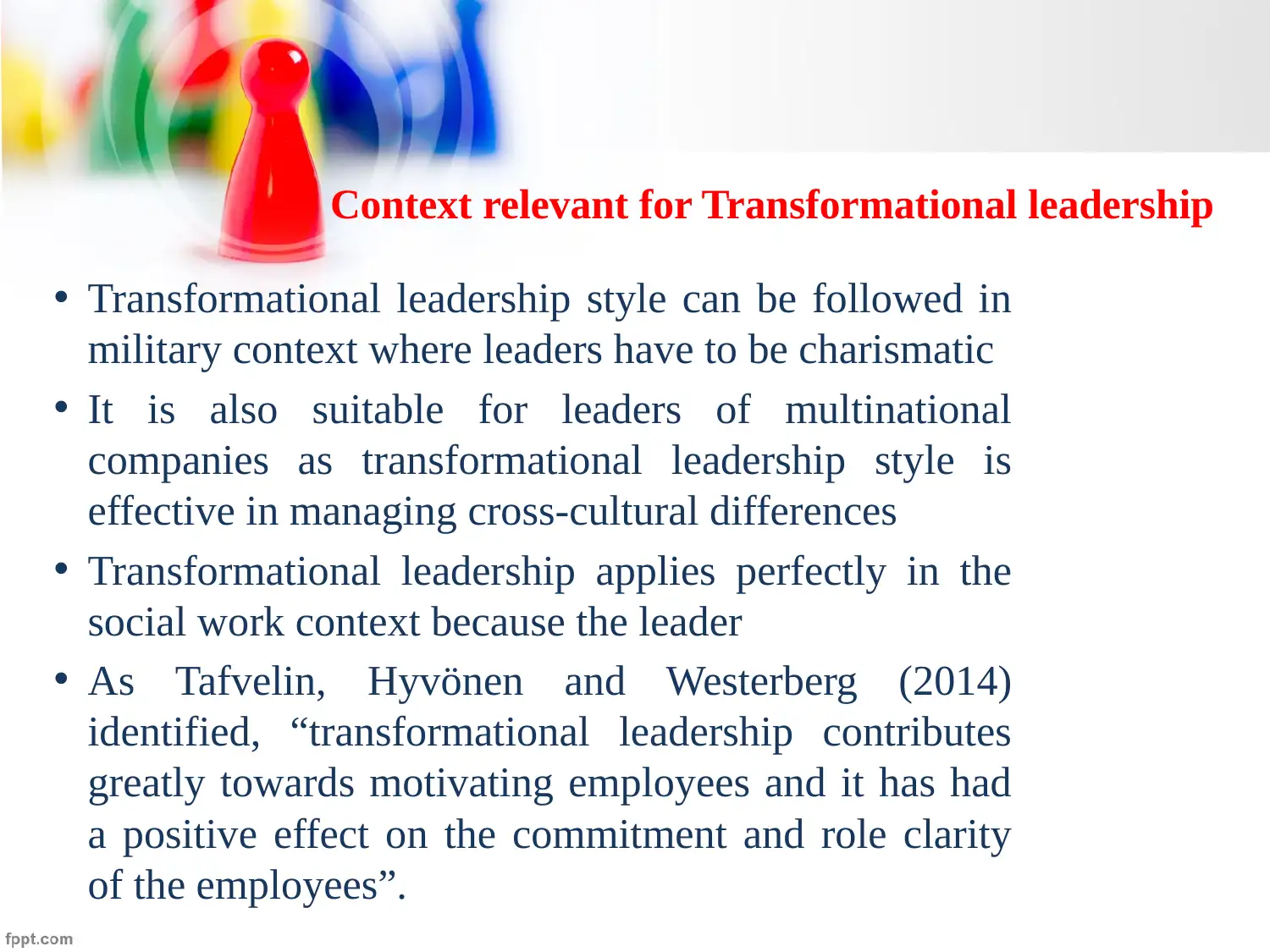
Context relevant for Transformational leadership
• Transformational leadership style can be followed in
military context where leaders have to be charismatic
• It is also suitable for leaders of multinational
companies as transformational leadership style is
effective in managing cross-cultural differences
• Transformational leadership applies perfectly in the
social work context because the leader
• As Tafvelin, Hyvönen and Westerberg (2014)
identified, “transformational leadership contributes
greatly towards motivating employees and it has had
a positive effect on the commitment and role clarity
of the employees”.
• Transformational leadership style can be followed in
military context where leaders have to be charismatic
• It is also suitable for leaders of multinational
companies as transformational leadership style is
effective in managing cross-cultural differences
• Transformational leadership applies perfectly in the
social work context because the leader
• As Tafvelin, Hyvönen and Westerberg (2014)
identified, “transformational leadership contributes
greatly towards motivating employees and it has had
a positive effect on the commitment and role clarity
of the employees”.
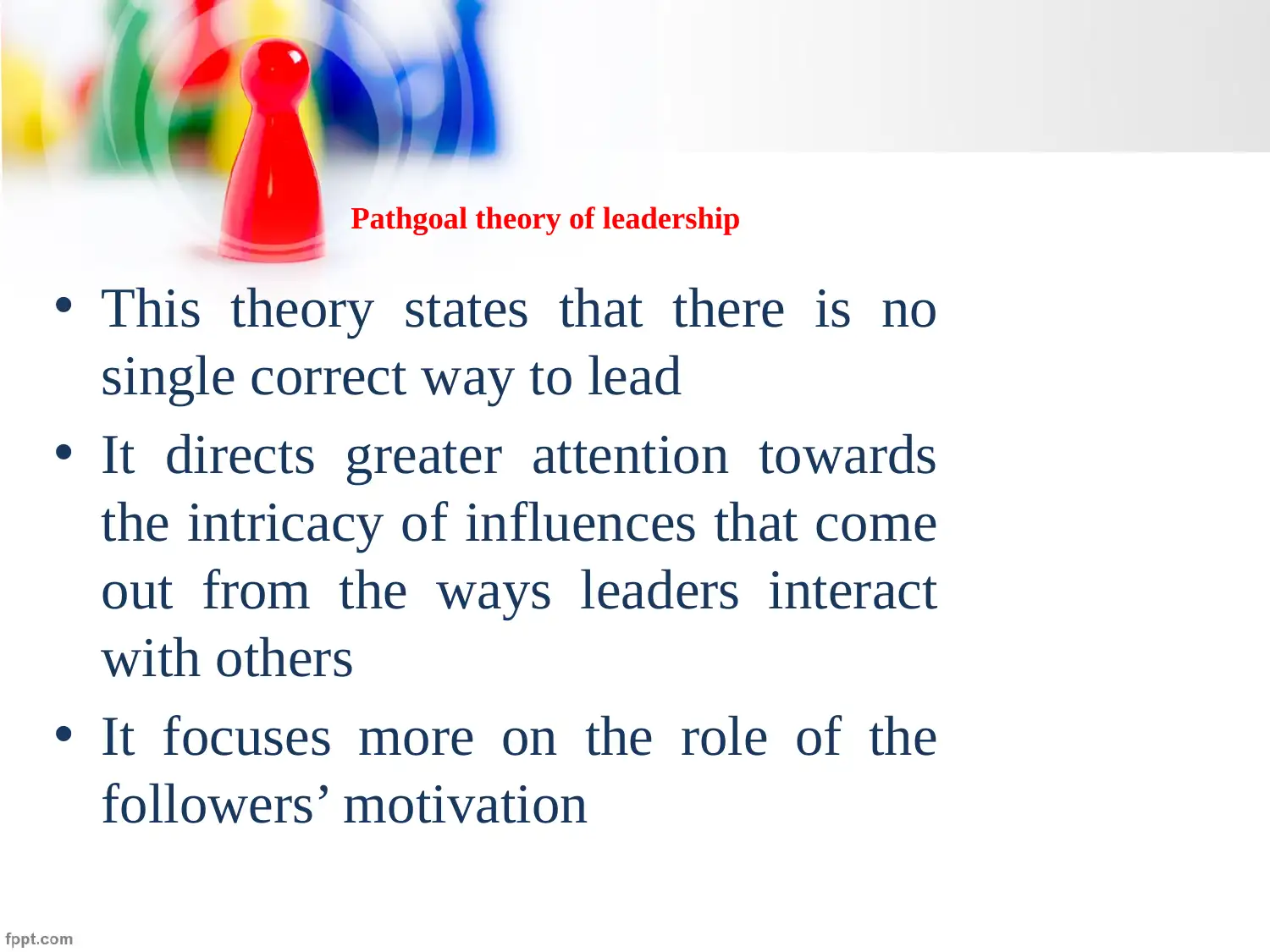
Pathgoal theory of leadership
• This theory states that there is no
single correct way to lead
• It directs greater attention towards
the intricacy of influences that come
out from the ways leaders interact
with others
• It focuses more on the role of the
followers’ motivation
• This theory states that there is no
single correct way to lead
• It directs greater attention towards
the intricacy of influences that come
out from the ways leaders interact
with others
• It focuses more on the role of the
followers’ motivation
⊘ This is a preview!⊘
Do you want full access?
Subscribe today to unlock all pages.

Trusted by 1+ million students worldwide
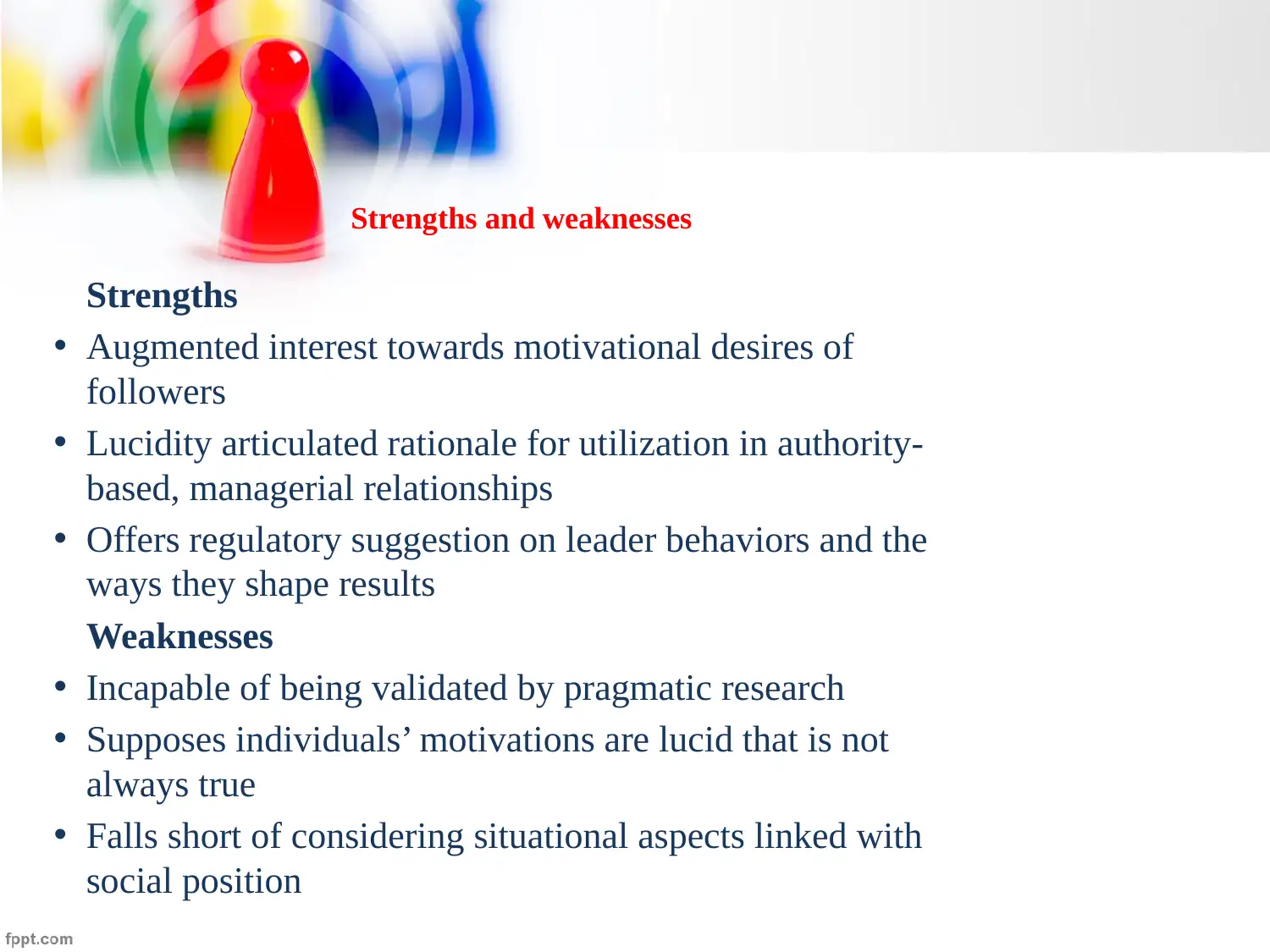
Strengths and weaknesses
Strengths
• Augmented interest towards motivational desires of
followers
• Lucidity articulated rationale for utilization in authority-
based, managerial relationships
• Offers regulatory suggestion on leader behaviors and the
ways they shape results
Weaknesses
• Incapable of being validated by pragmatic research
• Supposes individuals’ motivations are lucid that is not
always true
• Falls short of considering situational aspects linked with
social position
Strengths
• Augmented interest towards motivational desires of
followers
• Lucidity articulated rationale for utilization in authority-
based, managerial relationships
• Offers regulatory suggestion on leader behaviors and the
ways they shape results
Weaknesses
• Incapable of being validated by pragmatic research
• Supposes individuals’ motivations are lucid that is not
always true
• Falls short of considering situational aspects linked with
social position
Paraphrase This Document
Need a fresh take? Get an instant paraphrase of this document with our AI Paraphraser
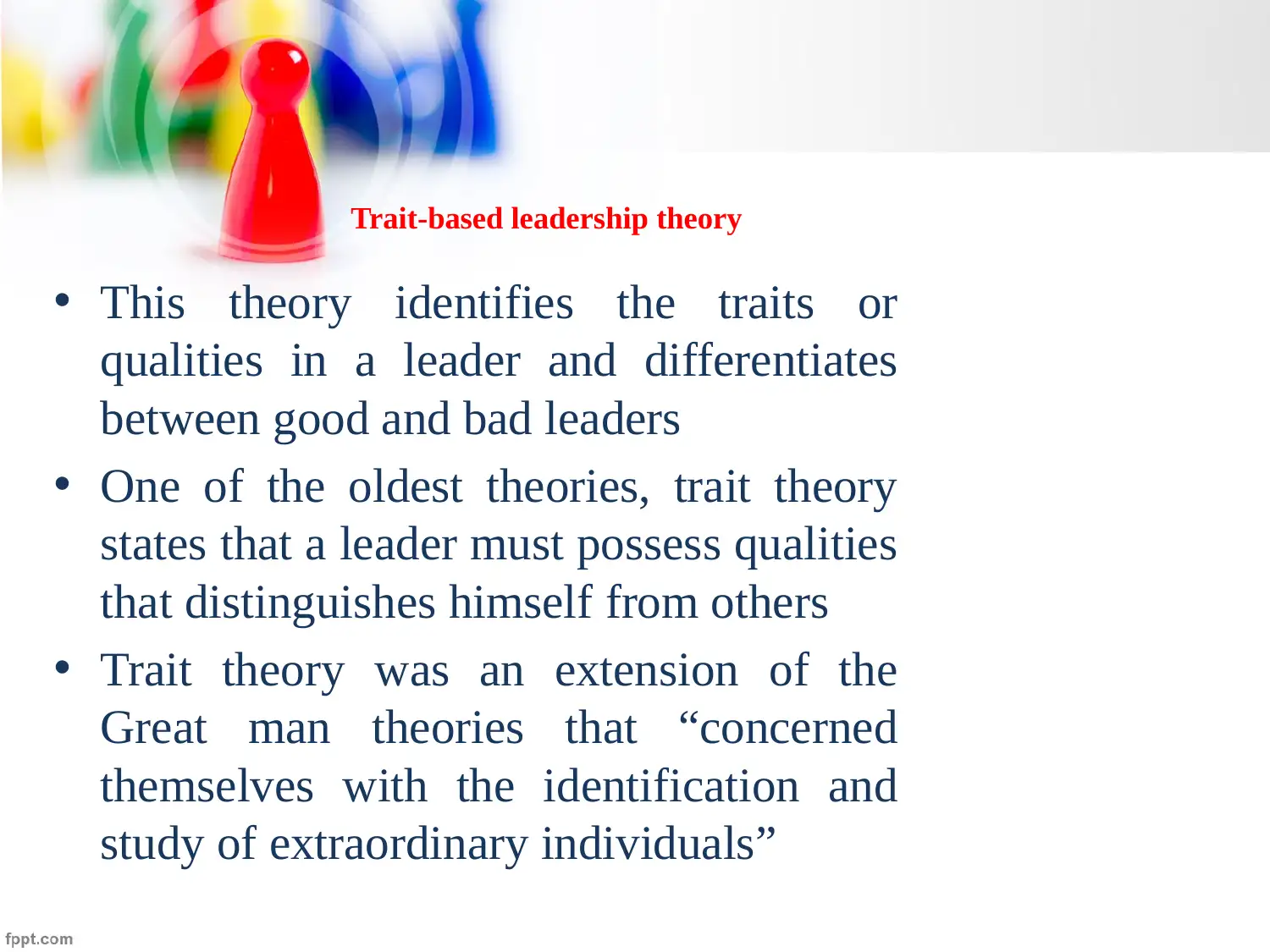
Trait-based leadership theory
• This theory identifies the traits or
qualities in a leader and differentiates
between good and bad leaders
• One of the oldest theories, trait theory
states that a leader must possess qualities
that distinguishes himself from others
• Trait theory was an extension of the
Great man theories that “concerned
themselves with the identification and
study of extraordinary individuals”
• This theory identifies the traits or
qualities in a leader and differentiates
between good and bad leaders
• One of the oldest theories, trait theory
states that a leader must possess qualities
that distinguishes himself from others
• Trait theory was an extension of the
Great man theories that “concerned
themselves with the identification and
study of extraordinary individuals”
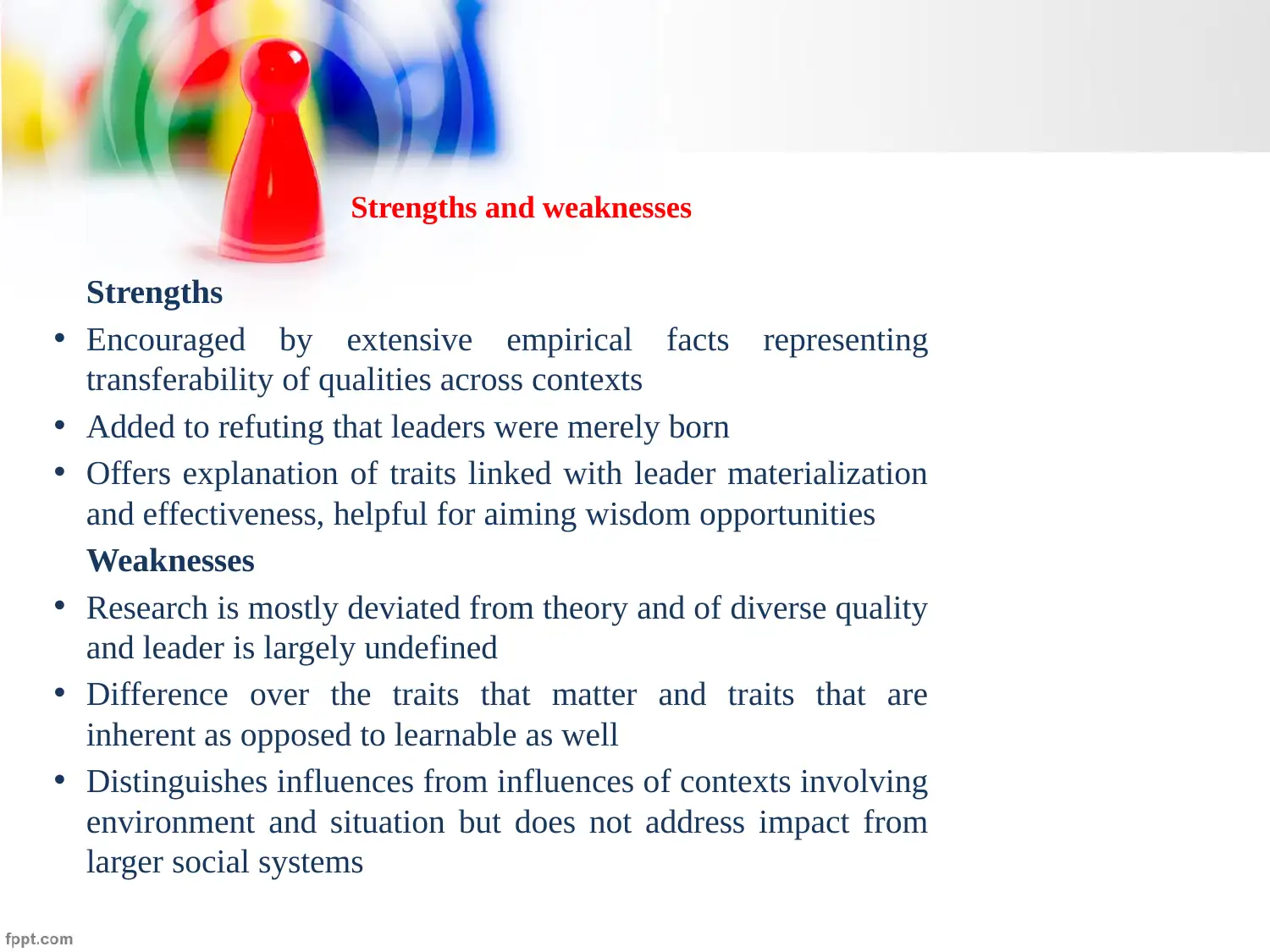
Strengths and weaknesses
Strengths
• Encouraged by extensive empirical facts representing
transferability of qualities across contexts
• Added to refuting that leaders were merely born
• Offers explanation of traits linked with leader materialization
and effectiveness, helpful for aiming wisdom opportunities
Weaknesses
• Research is mostly deviated from theory and of diverse quality
and leader is largely undefined
• Difference over the traits that matter and traits that are
inherent as opposed to learnable as well
• Distinguishes influences from influences of contexts involving
environment and situation but does not address impact from
larger social systems
Strengths
• Encouraged by extensive empirical facts representing
transferability of qualities across contexts
• Added to refuting that leaders were merely born
• Offers explanation of traits linked with leader materialization
and effectiveness, helpful for aiming wisdom opportunities
Weaknesses
• Research is mostly deviated from theory and of diverse quality
and leader is largely undefined
• Difference over the traits that matter and traits that are
inherent as opposed to learnable as well
• Distinguishes influences from influences of contexts involving
environment and situation but does not address impact from
larger social systems
⊘ This is a preview!⊘
Do you want full access?
Subscribe today to unlock all pages.

Trusted by 1+ million students worldwide
1 out of 16
Related Documents
Your All-in-One AI-Powered Toolkit for Academic Success.
+13062052269
info@desklib.com
Available 24*7 on WhatsApp / Email
![[object Object]](/_next/static/media/star-bottom.7253800d.svg)
Unlock your academic potential
Copyright © 2020–2025 A2Z Services. All Rights Reserved. Developed and managed by ZUCOL.





